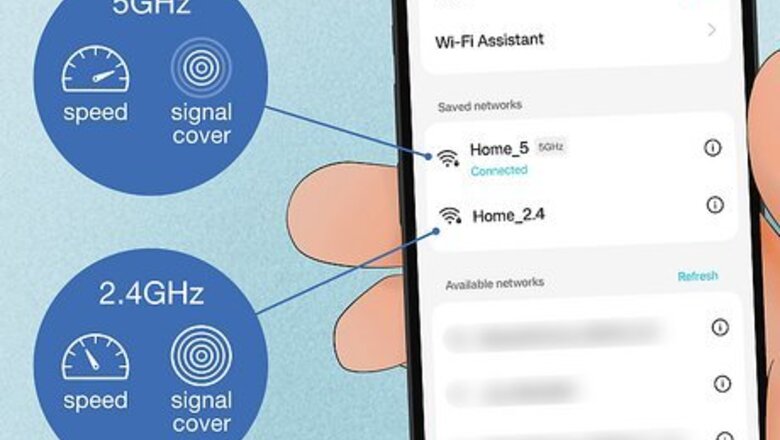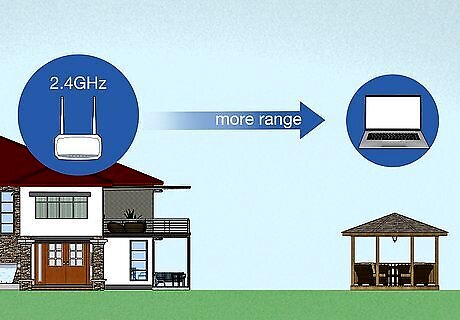
views
- A 5 GHz network is faster and more reliable but doesn't cover as much range.
- A 2.4 GHz network is slower but covers a wider range and is able to penetrate walls and solid objects more easily.
- A 2.4 GHz network is more susceptible to interference from other devices.
The Difference Between 2.4 GHz and 5 GHz

2.4 GHz and 5 GHz refer to the frequency of the wireless radio signal. Most newer dual-band routers allow you to connect to one of two wireless networks; a 2.4 GHz network, or a 5 GHz network. The biggest difference between these two networks is speed and range. 2.4 GHz offers a slower connection speed but covers a wider area. 5 GHz offers a faster connection speed but doesn't cover as wide of an area. Most dual-band routers broadcast both networks at the same time, allowing you to connect any device to whichever network you choose. Some older routers that only support one network may require you to configure your router in order to select whichever network you want to use. In addition to 2.4 GHz and 5 GHz, there are also wireless routers that support Wi-Fi 6E which adds a 6 GHz band that supports even faster connections with lower latency.
Pros and Cons of 2.4 GHz

Pros of using a 2.4 GHz network: 2.4 GHz covers a wider range of up to about 150 feet or 45 meters under ideal conditions. 2.4 GHz is better able to penetrate walls and solid objects. More devices can connect to a 2.4 GHz network.

Cons of using a 2.4 GHz network: 2.4 GHz is slower than a 5 GHz network, reaching speeds of up to 300 Mbps under ideal conditions. 2.4 GHz is more susceptible to interference from other devices. 2.4 GHz is less reliable than a 5 GHz network and more prone to network drops.
Pros and Cons of 5 GHz

Pros of using a 5 GHz network. 5 GHz is faster, able to reach speeds of up to 1.3 Gbps under ideal conditions. 5 GHz is less prone to interference from other devices. 5 GHz is more reliable and provides a more stable connection.

Cons of using a 5 GHz network: 5 GHz doesn't cover as much range, topping out at about 90 feet or 27 meters. 5 GHz is less able to travel through walls and solid devices. Not as many devices can connect to a 5 GHz network.
When You Should Use a 2.4 or 5 GHz Network

When you should use a 2.4 GHz network. You should connect to a 2.4 GHz network under the following conditions. Connect to a 2.4 GHz network if you need range. If you live in a larger house and you have a portable device, such as smartphone or laptop, and you need more range to cover all the rooms, or if you want to work in your backyard, it's better to connect to a 2.4 GHz network. Alternatively, you can use Wi-Fi extenders or connect another router to expand your Wi-Fi network. Connect to a 2.4 GHz network if walls or obstacles are interfering with your connection. Some devices can only connect 2.4 GHz. Many devices, such as appliances and smart lightbulbs, cannot be connected to a 5 GHz network.

When you should use a 5 GHz network. You should use a 5 GHz network under the following conditions: Use 5 GHz when you need a faster and more reliable internet connection. A 5 GHz network is better suited for activities that require a faster and more stable internet connection. Activities like online gaming or live streaming. Use 5 GHz if you are receiving interference from other devices. Devices such as garage door openers and other cell phones also use 2.4 GHz. This can interfere with your network connection and cause connection drops. Use 5 GHz when you are within range of your wireless router. Generally speaking, if you are close enough to your router that you are able to receive a 5 GHz signal, you should connect to 5 GHz. It's faster and more reliable.
















Comments
0 comment